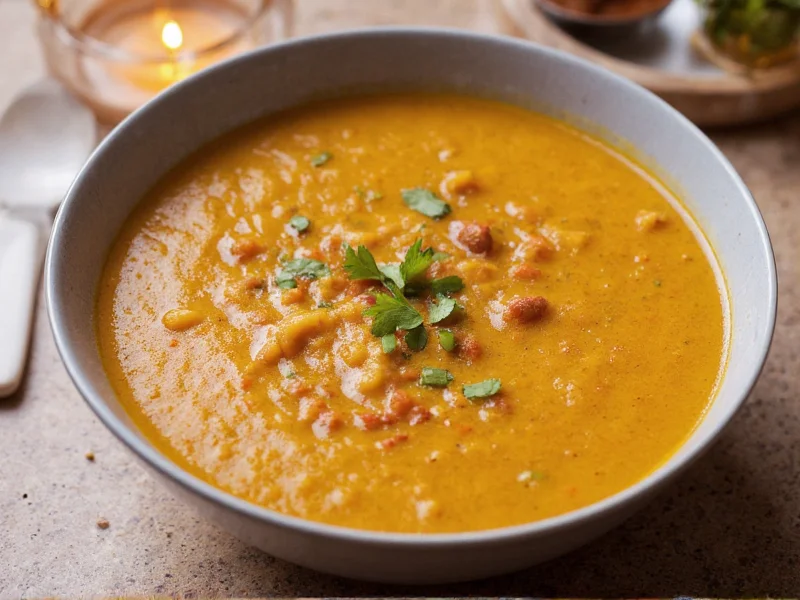Understanding Authentic Dahl: More Than Just Soup
While often called “dahl soup” in Western contexts, this beloved dish doesn't technically qualify as soup in Indian culinary tradition. Authentic dahl features a thick, creamy texture achieved through slow cooking lentils until they break down completely, creating a nourishing staple that’s been feeding South Asian communities for centuries. The confusion arises from cultural translation – what Westerners perceive as “soup” is actually a fundamental component of daily meals in India, typically served alongside rice or flatbreads.
The Cultural Significance of Dahl in Indian Cuisine
Dahl represents one of India’s most democratic dishes – accessible to all economic classes yet adaptable to regional preferences. Historical records show lentils have been cultivated in the Indian subcontinent since 2500 BCE, making dahl one of the world’s oldest prepared foods. In traditional Indian households, dahl isn’t considered a special occasion dish but rather dal roti – the essential combination of lentils and bread that forms the backbone of daily nutrition.
Essential Components of Traditional Dahl
Authentic dahl requires three fundamental elements working in harmony:
| Component | Function | Common Examples |
|---|---|---|
| Lentils/legumes | Protein base & texture | Masoor (red lentils), Toor (pigeon peas), Chana (chickpeas), Urad (black gram) |
| Tadka (tempering) | Flavor foundation | Cumin seeds, mustard seeds, asafoetida, dried red chilies in hot oil |
| Aromatics | Flavor complexity | Onion, garlic, ginger, tomatoes, fresh cilantro |
Nutritional Benefits of Homemade Dahl
Unlike processed “soup” products, authentic dahl provides complete nutritional value when prepared traditionally. A single serving (1 cup) of homemade masoor dahl typically contains:
- 23 grams of plant-based protein
- 15 grams of dietary fiber
- Significant iron, folate, and magnesium
- Naturally low fat content (under 3g per serving)
- No added preservatives or artificial ingredients
The slow-cooking method enhances nutrient bioavailability while the spice combinations aid digestion – particularly turmeric’s curcumin and asafoetida’s digestive properties.
Classic Masoor Dahl Recipe: Step-by-Step
This authentic preparation method yields the characteristic creamy texture without needing cream or coconut milk (common Western adaptations):
- Prepare lentils: Rinse 1 cup red lentils (masoor dal) until water runs clear. Soak for 20 minutes.
- Cook lentils: Combine lentils with 3 cups water, 1/2 tsp turmeric, and 1 tsp salt. Simmer uncovered for 25-30 minutes until completely soft.
- Prepare tadka: Heat 2 tbsp ghee in separate pan. Add 1 tsp cumin seeds, 1/2 tsp mustard seeds, 1 dried red chili, and a pinch of asafoetida. Cook until seeds pop.
- Add aromatics: Stir in 1 chopped onion, 1 tbsp ginger paste, and 2 minced garlic cloves. Cook until golden.
- Build flavor: Add 1 chopped tomato and 1/2 tsp each coriander powder, cumin powder, and red chili powder. Cook until oil separates.
- Combine: Whisk cooked lentils into tempering mixture. Simmer 10 minutes on low heat.
- Finish: Stir in 1 tbsp lemon juice and fresh cilantro. Adjust salt to taste.
Regional Dahl Variations Across India
India’s diverse regions have developed distinctive dahl preparations reflecting local ingredients and traditions:
- Punjabi Dal Makhani: Uses black lentils and kidney beans slow-cooked with butter and cream
- Gujarati Dal Dhokli: Features wheat dumplings simmered directly in spiced lentils
- Tamil Sambar: Tamarind-based lentil stew with vegetables and curry leaves
- Bengali Dal Pitha: Lentil dumplings served in thin, spiced broth
- Rajasthani Panchratna Dal: Five-lentil combination with royal spice profile
Serving Authentic Dahl: Beyond the Bowl
Traditional dahl service follows specific cultural practices that enhance both flavor and digestion:
- Serve hot over steamed basmati rice (dal chawal)
- Add a swirl of fresh ghee on top for enhanced flavor absorption
- Accompany with yogurt (raita) to balance spices
- Include pickled vegetables (achar) for contrasting flavors
- Always pair with fresh flatbread (roti or naan) for scooping
Storage and Reheating Best Practices
Authentic dahl often improves in flavor after resting. Follow these guidelines for optimal results:
- Cool completely before refrigerating in airtight container
- Refrigerated dahl stays fresh for 4-5 days
- Freeze in portion-sized containers for up to 3 months
- Reheat gently with 2-3 tbsp water to restore creamy texture
- Always add fresh tadka when reheating for maximum flavor
Common Dahl Preparation Mistakes to Avoid
Even experienced cooks make these errors when preparing traditional dahl:
- Skipping the tadka: This tempering step is essential for authentic flavor development
- Overcooking aromatics: Burnt onions or garlic create bitter notes that ruin the dish
- Using wrong lentil: Each dahl variation requires specific lentils for proper texture
- Adding salt too early: Salt added during initial cooking can prevent lentils from softening properly
- Stirring too vigorously: Aggressive stirring breaks down lentils too much, creating gluey texture











 浙公网安备
33010002000092号
浙公网安备
33010002000092号 浙B2-20120091-4
浙B2-20120091-4